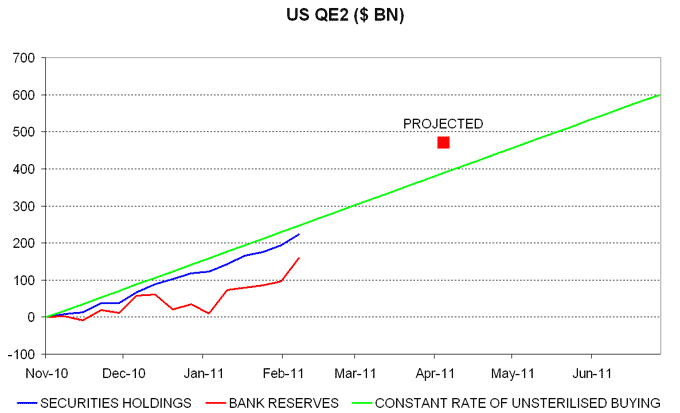QE2 on steroids: SFP run-down to accelerate US reserves surge
The US Treasury's decision to reduce its "supplementary financing program" (SFP), under which it issues additional bills and places the proceeds on deposit at the Federal Reserve, will result in a large increase in bank reserves and the monetary base over coming weeks, on top of the impact of the Fed's continuing securities purchases.
The SFP is being run down to delay the national debt hitting the current authorised ceiling of $14.29 trillion, which Congressional Republicans are resisting increasing. Even with this initiative, debt is expected to reach the limit by mid-May at the latest. The Treasury has announced that the SFP will decline from $200 billion to $5 billion. A reduction to $175 billion occurred over the last week.
The $195 billion planned decline will feed directly into bank reserves and the monetary base (i.e. reserves plus currency in circulation) as the Treasury repays bills by running down the balance in its Fed account.
As previously noted, the Fed is on track with its plan to buy a net $600 billion of securities by mid-2011 but the increase in bank reserves has so far fallen short of purchases – see chart. This seems to reflect exogenous factors (such as a repayment of Fed credit by AIG) though could hint that officials are becoming concerned about overstimulating the economy.
The SFP run-down, however, is likely to push bank reserves and the monetary base above the QE2-implied path. Assuming that the SFP falls to $5 billion as planned, and continuing Fed securities purchases are unsterilised, reserves may reach about $1.46 trillion by the start of April – $470 billion or 48% more than when QE2 was announced in early November. Completion of the QE2 programme would imply a rise to about $1.68 trillion by mid-year – equivalent to 11% of annual GDP.
A further liquidity injection could sustain increases in commodity prices, fuelling bond market inflation worries. With the US economy apparently performing strongly in early 2011, the Fed may soon come under pressure to scale back QE2 or sterilise the impact, for example by auctioning term deposits.


Reader Comments